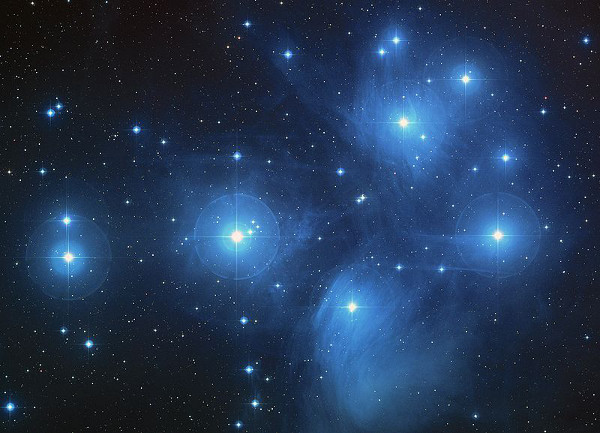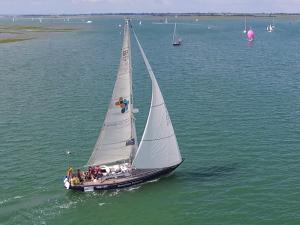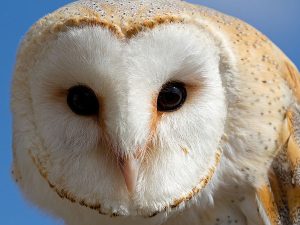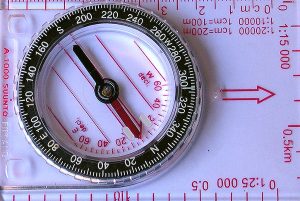Stargazing - introduction

“We are all in the gutter, but some of us are looking at the stars.” – Oscar Wilde
Contents
What is stargazing?
Stargazing, or astronomy, is the study and enjoyment of the stars. Actually, it’s not just about stars – other objects visible in the night sky include galaxies (groups of billions of stars); planets (which orbit stars); and other rocky things flying around in space, like asteroids (chunks of rock in orbit around stars – there’s an asteroid belt between Mars and Jupiter); comets (chunks of rock that come from outside our solar system); meteoroids (similar to asteroids, but much smaller); meteors (‘shooting stars’, when a meteoroid enters the earth’s atmosphere and burns up – and if it reaches the earth, it’s called a meteorite).
A star is a ball of gas so massive that its gravity causes unimaginable numbers of nuclear fusion reactions at its core, which give off heat and light. They are like gigantic forges that create all the different elements that are eventually scattered across the universe when stars explode as supernovae. We (and everything else on earth, including the earth itself) are all ultimately made of ‘stardust’.

We now know that the universe is some 13-14 billion years old and composed of many billions of galaxies. Our own galaxy, the Milky Way (we can sometimes see its ‘arms’ as the ‘milky’ band stretching across the whole sky on a clear night), is in turn home to our solar system, comprising the Sun, its orbiting planets (including the Earth) and numerous moons, asteroids, rocks, and dust. Our Sun is a 4.5-billion-year-old, third-generation star – just one star among the 100-400 billion stars in our galaxy – on course to explode in another 5 billion years or so after expanding and swallowing up everything else in the solar system.
Distances to stars and galaxies are so huge that they’re usually measured in light-years, i.e. the number of years that it takes for their light to reach us. So if the light from a star (travelling at almost 300,000 km per second) takes 100 years to reach us, it’s 100 light-years away. So when we look at the stars, we’re looking back in time – even the Sun, the light from which takes 8 minutes 20 seconds to reach us.
More on the Milky Way – 100-400 billion stars; 100-150,000 light-years across; we’re about 27,000 light-years from the centre, where there is a black hole.
History
Dating back to prehistory, it’s perhaps the oldest of the natural sciences and was originally closely interwoven with religious, mythological and cosmological beliefs and practices. The seasons were very important to early agrarian communities and the stars served as a calendar: while some stars and constellations (groups of stars, and sometimes galaxies, that look as though they’re grouped together when viewed from Earth) are visible year-round, others can only be seen at certain times of year, giving an indication of the changing seasons. One theory is that Stonehenge may have been a primitive ‘computer’ used to predict solar events. For millennia people were extremely superstitious about the stars, believing them to control human destiny. Soothsayers and sages made predictions based on events in the heavens, and occurrences such as eclipses were seen as powerful, potentially dangerous portents. The stars were also fundamental to early navigators, who used them as a guide.

While early civilisations made important observations about the positions of celestial bodies, the appearance of comets, the times of eclipses etc., it was the ancient Greeks who really refined astronomy into a science. They used mathematical formulae to calculate how far away the Sun and planets were, and proposed models to explain the apparently random movements of the planets (‘planet’ translates as ‘wanderer’ because they take a different path across the sky from the stars). The astronomer Ptolemy hypothesised that the planets moved in small circles within a larger orbit around the Earth, and that the stars too, orbited the Earth (the geocentric model).
Many centuries later, the Renaissance ushered in a great age of science and discovery, marking the beginning of true astronomy in Europe. Nicolaus Copernicus dared to champion the heliocentric model of the universe, in opposition to the prevailing geocentric view. Galileo attempted to settle the debate using one of the first telescopes, to observe moons orbiting Jupiter. He reasoned that if they didn’t orbit the Earth then maybe the stars didn’t either. Unfortunately, such radical ideas ran counter to Church doctrine and he was put under house arrest for the rest of his life. The Scandinavian Tyco Brahe compiled intricate data on the planets, which were used by his collaborator Johannes Kepler to describe their elliptical orbits around the sun. The orbits of the planets were explained by Newtonian mechanics and later refined by Einstein’s Theory of Relativity.

In the early 20th century, Georges Lemaître proposed that the universe was created by rapidly expanding concentrated energy (now known as the Big Bang theory). Shortly afterwards, Edwin Hubble discovered that all parts of the universe are indeed moving away from each other. The further away something is, the further towards the red end of the spectrum is the light it gives off (‘red shift’). By contrast, an object moving towards us gives off higher energy blue light. Hubble realised that by establishing where the light from a particular star or planet is on the spectrum we can work out how far away it is and which way it is travelling. Around the same time, an early astronomical photograph of the Andromeda Galaxy (previously thought to be a solar system) led to a revolution in our understanding of the universe: for the first time people began to realise that the stars and other galaxies were hundreds if not thousands of light years away (we now know that Andromeda is in fact 2.5 million light years away). The discovery in the 1960s of cosmic microwave background (CMB) radiation, or ‘echoes’ of the Big Bang finally led to it being adopted as the standard explanation for the origin of the universe.

Are we alone?
In the 1960s, scientists also began to look for evidence of alien life. Certain sugar molecules have been discovered in distant clouds of gas and dust that have the potential to create the basic building blocks of DNA; and there are potentially hundreds or thousands of planets with the conditions required to support life in our galaxy alone. Although nothing has been found so far (and at our level of technology, our attempts can only reach a relatively tiny distance), the search for alien life and other inhabitable planets is very much a part of modern astronomy, and astrobiology. Maybe we won’t be alone for much longer (but then there’s Fermi’s Paradox).
What are the benefits of stargazing?
The benefits of stargazing can be roughly grouped into navigation, inspiration and contribution. A little knowledge about the positions of the major constellations can help to orientate you and, once mastered, celestial navigation techniques can be used anywhere in the world.

Stargazing is great for getting you out of doors and learning about the night sky. Apart from anything else, staring up at a sky full of stars is a beautiful, awe-inspiring experience that really puts things in perspective. It’s mind-blowing to think about how small and young we (modern humans are around 150,000 years old, depending on where you draw the line) and our planet (4.3 billion years) are. Kids in particular tend to love learning about the stars, and astronomy is great for encouraging an interest in the world around them (hunting for aliens seems to be particularly appealing).
Astronomy also gives ordinary people the chance to contribute to advancing our knowledge of the universe. It’s one of the few sciences where amateurs and professionals can really engage in a conversation, and amateur astronomers get to participate in huge discoveries and projects such as Galaxy Zoo which rely on volunteers to categorise objects (the human brain still processes these images better than computers). Astronomy has long been the testing ground for physicists like Einstein, and revolutionary discoveries are still being made all the time. It’s a growing, evolving branch of physics that has the power to astonish and delight us. And who knows, spend long enough looking up and you might be lucky enough to be the first to spot a comet and have it named after you.

What can I do?
Before you start
Astronomy is a huge field, but you can take baby steps by learning the patterns of the planets’ orbits, the main groups of stars and constellations, and the lunar monthly and annual cycles. There are lots of websites and books to help you, or you could join an astronomy association and maybe meet like-minded stargazers. See books and links (see resources). Reading about NASA’s astronomy picture of the day over the course of a few months can also teach you a lot; plus it might be a really good idea to visit a planetarium – here’s how to find one near you in the UK and around the world.

Light pollution
It’s easier to see stars if it’s not a full moon (and the newer the better), and you’re away from artificial lights. Don’t be put off completely if you live in a city or an area with a lot of light pollution, however. While everyone should experience the breathtaking sight of stars in a really dark sky at least once in their lifetime (the UK has a few ‘dark parks’ where you can do this – see Dark Sky Discovery), for stargazing beginners, a certain amount of light pollution can actually make it easier to pick out the larger, brighter stars and constellations.
Time lapse video of a meteor shower in California; meteors are space rocks that enter the Earth’s atmosphere and burn up, causing a ‘shooting star’, and meteorites are the ones that make it to Earth.
Naked eye, binoculars or telescope?
You can start stargazing tonight, without any equipment at all. There’s a lot you can see and learn just with the naked eye. See here. You’ll see more with a good-quality pair of binoculars, which will set you back about £60. Consider buying a camera tripod mount to keep them steady.
If you get sufficiently hooked to want to buy your own telescope, a good entry level one can be had for around £120-£150. The bigger it is, the more sensitive it will be. Don’t rush into buying one however; it’s worth saving up for a good-quality one and finding someone who can teach you to set it up properly (maybe someone from a local association?). See our links page for more. You can also buy auto-navigating telescopes that zoom around the sky to show you different things, but you’re not as likely to really learn for yourself this way.

Safety
Stargazing is a very safe activity, but if you’re going to be spending time outdoors at night then make sure you’re well wrapped up, have sufficient food, water and a fully-charged phone. Also, let someone know where you’re going and make sure you don’t fall into any holes while you’re gazing up at the sky.
Thanks to Olly Greenwood for information.
Whilst you’re here, why not take a look at the other 25+ nature topics available? And don’t forget to visit our main topics page to explore over 200 aspects of low-impact living and our homepage to learn more about why we do what we do.
The specialist(s) below will respond to queries on this topic. Please comment in the box at the bottom of the page.

Neill Sanders is a keen amateur astronomer based in the North East of England. His interest in astronomy is predominantly outreach. He loves to show people around the night sky and view extraordinary objects such as galaxies, star clusters and nebulae using large-aperture telescopes. In addition, Neill runs the Go Stargazing website, which he uses to encourage public interest and participation in astronomy by featuring dark sky locations, the best places to stargaze, observatories, public stargazing events and stargazing-friendly accommodation across the UK.






